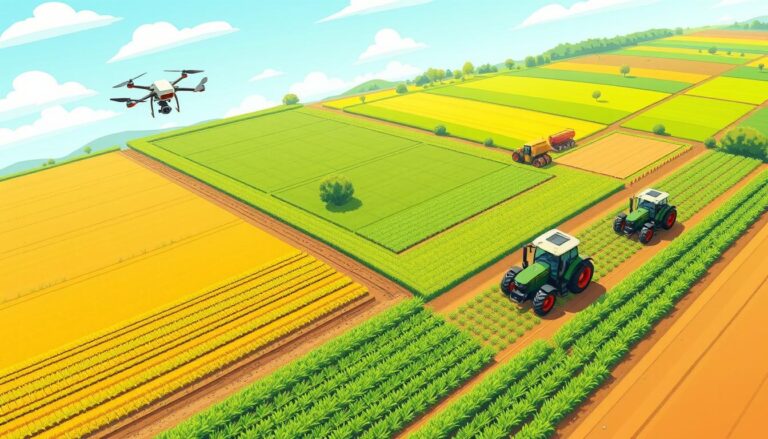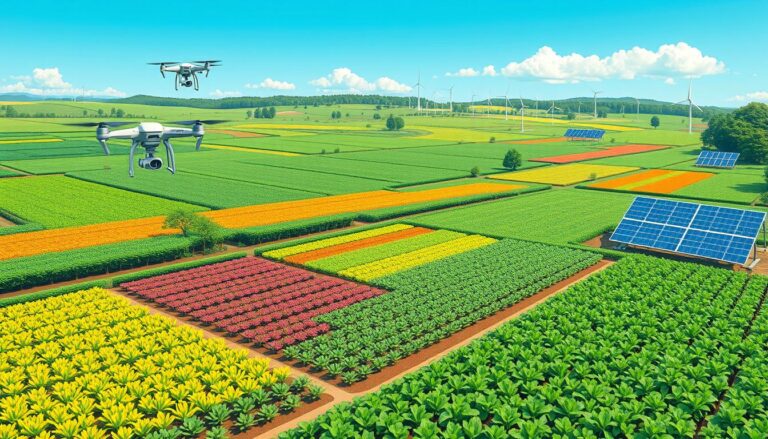Climate Monitoring Tech
In today’s world, tracking and understanding environmental changes is key. We use environmental sensors, weather data analysis, and sustainable tech to do this. This helps us understand the Earth’s climate system better.
The World Meteorological Organisation (WMO) is vital in promoting climate monitoring best practices. It supports 189 member states’ National Meteorological or Hydrometeorological Services (NMHS). The Global Climate Observing System (GCOS) also plays a big role. It focuses on 50 Essential Climate Variables (ECVs) across different domains.
Climate monitoring tech includes many tools and methods. From satellite observations to ground-based data, we use them all. By analyzing this data with advanced methods and AI, scientists can make better climate models. This info is key for making policy decisions and finding ways to fight climate change.
Key Takeaways
- Climate monitoring technology integrates data from various sources to track and understand environmental changes.
- The WMO and GCOS support global climate monitoring efforts, focusing on essential climate variables.
- Advanced data analysis techniques and AI algorithms help improve climate models and predictions.
- Climate monitoring data informs policy decisions, conservation efforts, and sustainable technology development.
- Collaboration between governments, organizations, and stakeholders is crucial for effective climate action.
Understanding Climate Monitoring Technology
Climate monitoring technology is key to understanding and adapting to climate change. It measures atmospheric and surface variables. This technology is crucial for making informed decisions and developing strategies to fight climate change.
Definition and Importance
Climate monitoring technology uses special instruments to measure and record various variables. These include thermometers, barometers, and more. The data from these instruments helps us understand the Earth’s atmosphere, oceans, and land.
The World Meteorological Organisation (WMO) is vital in coordinating global climate monitoring. In 1992, the Global Climate Observing System (GCOS) was set up. It focuses on 50 Essential Climate Variables (ECVs) across different domains.
| Domain | Essential Climate Variables (ECVs) |
|---|---|
| Atmospheric | Air temperature, wind speed and direction, water vapor, pressure, precipitation, surface radiation budget |
| Oceanic | Sea-surface temperature, sea-surface salinity, sea level, sea state, ocean acidity |
| Terrestrial | River discharge, water use, snow cover, glaciers, ice caps, land cover, soil moisture, fire disturbance |
Types of Climate Monitoring Tools
Climate monitoring technology includes air quality monitoring, greenhouse gas measurement, and remote sensing technology. These tools help scientists collect data on various scales. They monitor climate changes over time.
New approaches like bio-indicators are also being used. Bio-indicators, such as monkey migration, can provide early warnings. They help communities adapt to environmental changes.
“Observations from bio-indicators provide essential early warnings along with meteorological data.” – Local communities in Kenya and Zimbabwe
As we face climate change, advanced monitoring technology is crucial. It informs policy decisions and guides efforts to mitigate and adapt to climate change impacts.
Key Players in Climate Monitoring
The climate monitoring sector is always changing. Companies big and small are working on new ways to fight climate change. They use meteorological instruments, climate modeling software, and carbon footprint tracking to collect and understand environmental data.
Leading Companies in the Sector
Aclima, Inc. is a big name in climate monitoring. It was started in 2010 in San Francisco, California. Aclima focuses on air quality and pollution, and has gotten Series B funding to grow its tech.
Watershed is another important company. It deals with emissions management and has also gotten Series B funding. This will help it expand its work.
Scopito from Denmark is known for its data management for visual inspections. Climatik, from Mexico, is a leader in wind resource assessment and meteorology. Climatik was founded in 2008 and has grown to cover major wind areas in Latin America.
Innovative Startups Making Waves
Recently, new startups have joined the climate monitoring field. Some of these include:
- Sylvera, started in 2020, is working on advanced carbon offset systems
- Solar AI Technologies, also from 2020, uses AI for solar energy
- AmphibiousAI LLC, a 2021 startup, focuses on sustainable amphibious vehicles
- Giki, from the UK, offers a mobile app for eco-friendly shopping, founded in 2017
Climate TRACE is a global effort by universities, scientists, and AI experts. They track greenhouse gas emissions from over 662 million sources. They use satellites and remote sensing to find and share data on emissions.
“Our mission is to accelerate climate action by providing independent, reliable, and timely greenhouse gas emissions data.”
– Climate TRACE
The table below shows some key trends and challenges for climate tech companies in 2024:
| Key Trends | Key Challenges |
|---|---|
| Carbon capture and sequestration (CCS) gaining traction | High Research and Development (R&D) Costs |
| Development of long-duration energy storage solutions | Navigating Regulatory Challenges |
| Rising interest in sustainable agriculture technologies | Scaling Across Sectors |
| Integration of AI into climate tech for environmental insights | Securing Sufficient Funding |
How Climate Monitoring Tech Works
Climate monitoring technology has changed how we track our environment. It uses advanced data collection and analysis. This lets scientists understand our planet’s climate system better than ever before.
Data Collection Methods
At the core of climate monitoring are many tools and methods. These include:
- Surface observations from weather stations and sensors
- Upper air measurements using weather balloons and radar
- Remote sensing technology such as satellites and drones
Planet Labs, for example, uses over 150 satellites to monitor our planet. They track things like biomass and snow cover. Saildrone also uses unmanned vehicles to collect data on the oceans, like sea temperature and salinity.
Data Analysis Techniques
After collecting data, advanced analysis techniques are used. These include:
| Technique | Description |
|---|---|
| Statistical analysis | Identifying trends, patterns, and correlations in climate data |
| Climate modeling software | Simulating future climate scenarios based on current data |
| Geospatial analysis | Mapping and visualizing climate data across geographic regions |
Aclima, for example, collected 42 million air quality measurements in California. They focused on ECVs like carbon dioxide and methane. Standardizing ECV measurements helps compare data from different sources.
Role of AI and Machine Learning
AI and machine learning are key as data grows. They automate data processing and find patterns humans can’t see. This helps in understanding climate data better.
“Automation through advances in machine learning and artificial intelligence helps in synthesizing enormous datasets for quick insights such as identifying pollution or deforestation areas.”
AI and machine learning give climate monitoring real-time updates and predictions. They provide insights for making decisions and policies to fight climate change.
Benefits of Climate Monitoring Technology
Climate monitoring technology has many benefits. It helps us understand our planet’s health better. It also helps us make choices to lower our carbon footprint and keep people safe.
Environmental Conservation
One big plus of climate monitoring tech is its help in saving the environment. It tracks carbon and air quality. This lets governments and companies know where to cut down on emissions.
For example, IoT sensors help with water and energy use. They also improve crop yields and cut down fuel use. These tools also protect ecosystems and manage water well.
Economic Insights
Climate monitoring tech also gives us economic benefits. It helps businesses save money by making smart choices. For instance, IoT sensors help fleet managers save on fuel and extend vehicle life.
Smart energy grids use IoT to manage power better. They also find leaks and speed up seismic data analysis. This helps in the energy sector.
Public Health and Safety
Climate monitoring tech is key for public health and safety. It tracks pollutants and emissions. This helps improve air quality and lower disease risks.
In London, air quality has improved by 20% in 2023. Early warning systems for extreme weather save lives and money. IoT devices like Forest Capsule detect wildfires early.
| Benefit | Example | Impact |
|---|---|---|
| Air Quality Improvement | Real-time pollution tracking systems in London | 20% improvement in air quality in 2023 |
| Wildlife Conservation | IoT sensors tracking endangered rhinoceroses in Kenya | 15% decrease in poaching incidents in monitored areas |
| Disaster Response | Real-time seismic sensors by the U.S. Geological Survey (USGS) | 30% reduction in earthquake response times |
As we keep using climate monitoring tech, we’ll see more benefits. We’ll see better environmental care, smarter economic choices, and safer public health.
Future Trends in Climate Monitoring
The world is facing big challenges with climate change. But, new tech in satellites, measuring greenhouse gases, and climate modeling is helping us understand our planet better. The market for climate tech is growing fast, expected to hit USD 182.54 billion by 2033.
Advances in Satellite Technology
Satellite tech is getting better, allowing us to collect more detailed data. This helps us track things like sea level rise and changes in plants. New startups and solutions are also working to make energy use more efficient and cheaper.
The Role of Citizen Science
More people are joining in on climate science through community projects. These efforts give us local insights and help people feel involved. Using advanced tech like AI will make climate monitoring better and more efficient.
Regulatory Impacts and Policy Support
World leaders are now seeing the value in climate monitoring. They’re making laws to help new tech get used more. Companies are using new climate tech to avoid fines and penalties.
New ways to capture carbon dioxide are showing promise. It’s clear that working together is key to using these technologies and keeping our planet safe.
Source Links
- COP29: Digital tech and AI can boost climate action, but curbing the sector’s emissions is key
- Digital tools key to fast-tracking climate action
- Leveraging large language models to monitor climate technology innovation
- Climate Change Monitoring | Climate Technology Centre & Network
- What Is Climate Tech? – Plural Policy
- What is Climate Tech? – Net Zero Insights
- Top 50 Innovative Climate Tech Companies to Watch in 2024
- Top 15 Climate Tech Startups Revolutionizing Sustainability in 2024
- What is climate technology? How It Works, Types, Adoption, and Examples
- 🌏 Technologies that monitor Earth’s vital signs | Climate Tech VC
- Climate Technology: Examples, Advancements & Investment
- How Internet of Things (IoT) technology helps address climate change and environmental challenges
- How Environmental Monitoring Benefits from IoT – African SME digital transformation using edge technology
- Climate Tech Market Trends, Outlook & Forecast by 2033 | FMI
- What’s next in climate tech: 6 trends for 2024







